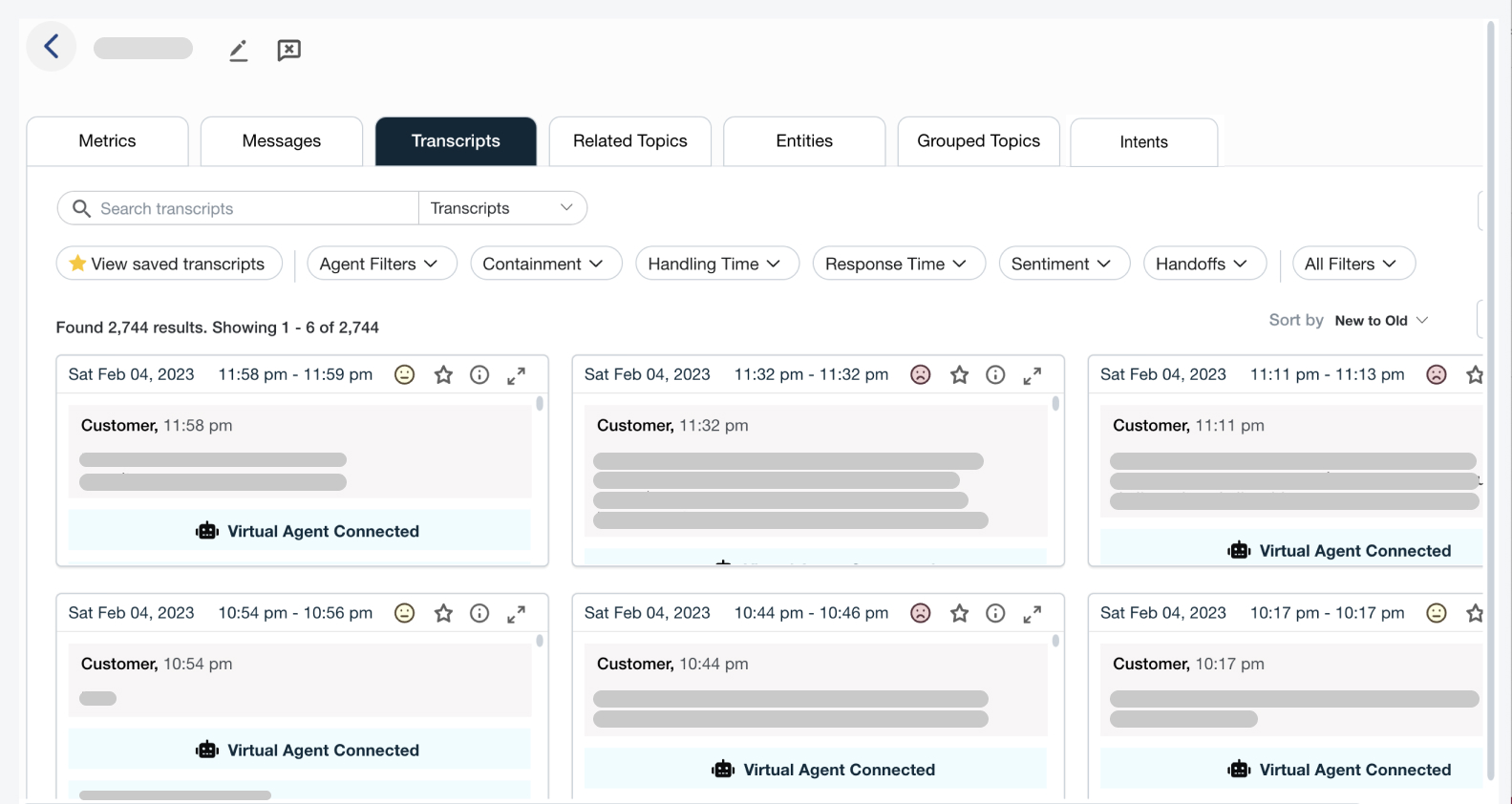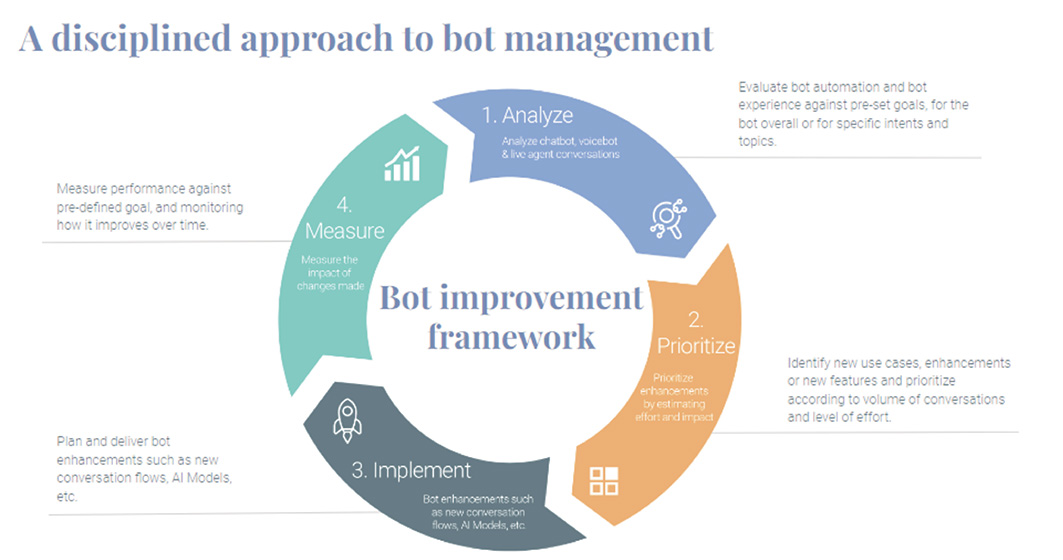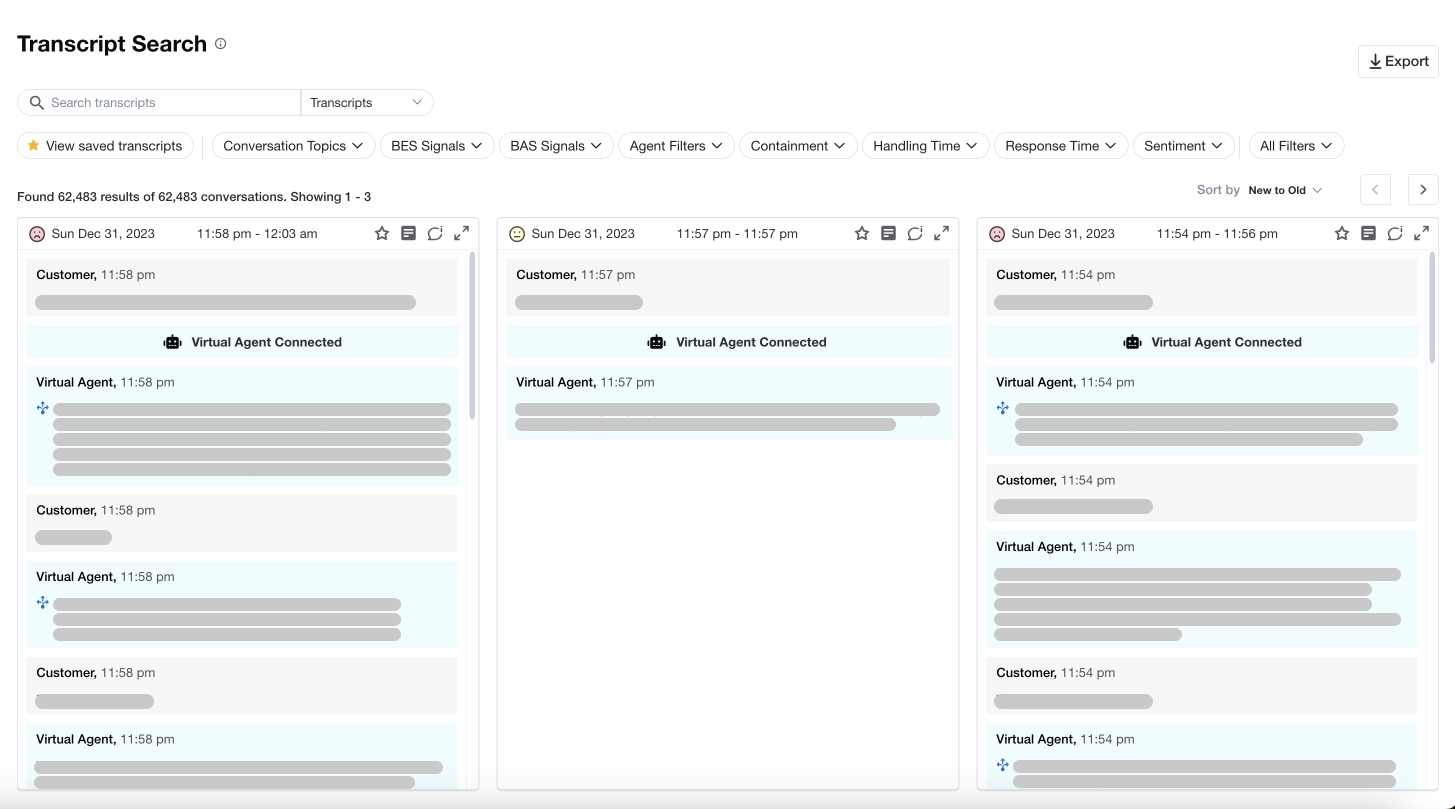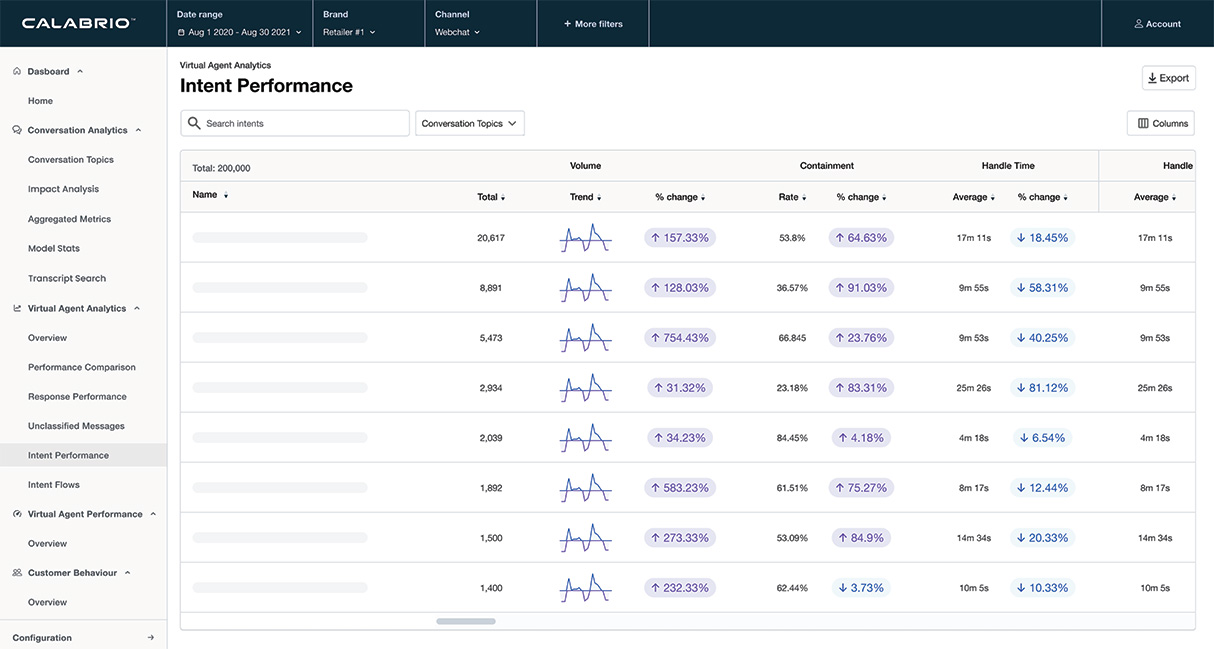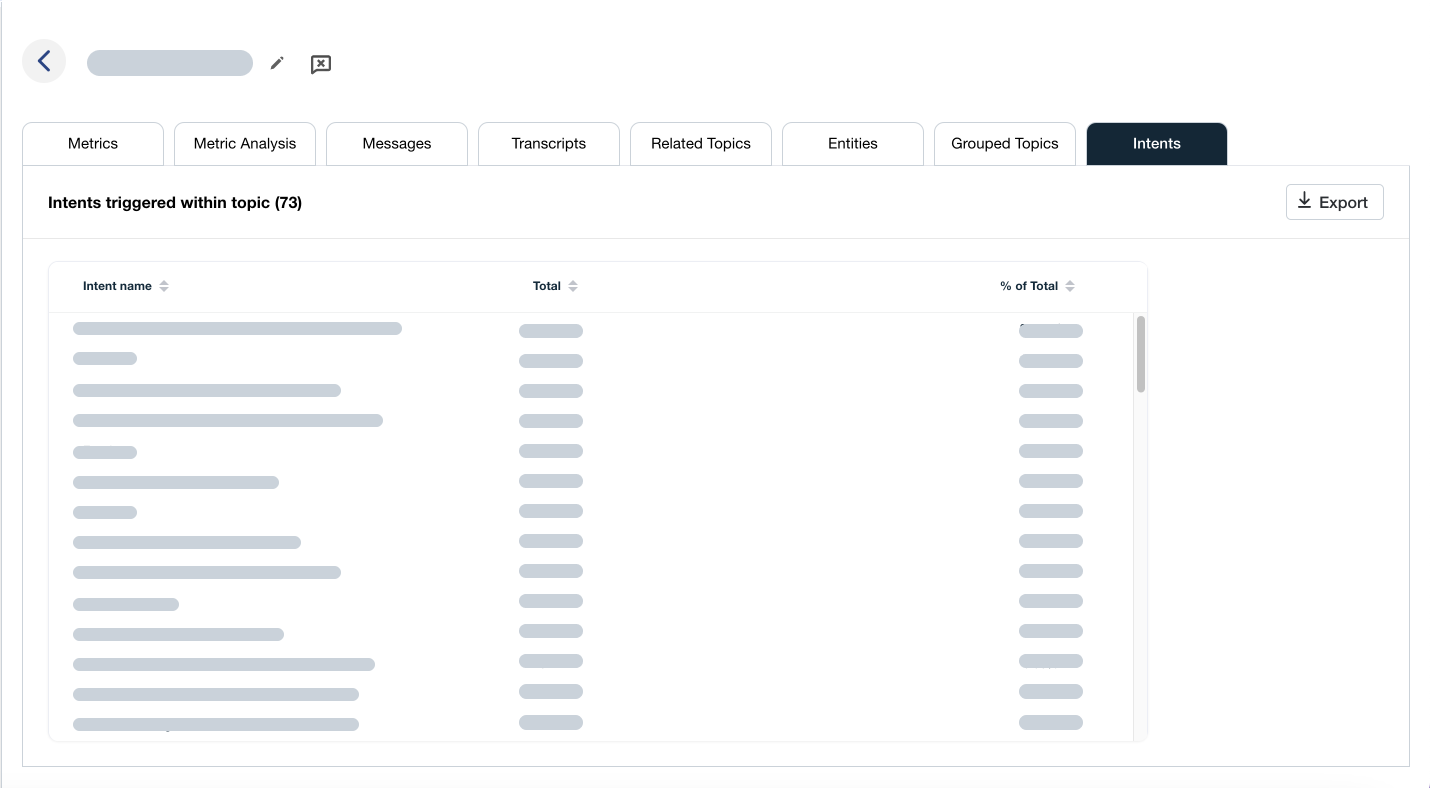- Products
- Solutions
Solutions
Services
- Resources
- Customers
Explore CSCCalabrio Success Center
Calabrio product training
- Partners
Contact Center AIFind More Great Content- Customer Interaction Analytics
- Workforce Management
- Customer Experience
- Quality Management
- Contact Center Reporting
- Managing a Remote Workforce
Home » Workforce Optimization » What is conversational bot management? How to get the most out of your chatbots
What is conversational bot management? How to get the most out of your chatbots
Conversational bot management, otherwise known as chatbot management, is essential for the success of your chatbot. Not only does the right approach to chatbot management ensure that bots are tuned for optimal automation, and high customer experience, delivering consistently useful and accurate results, but it also allows you to monitor and improve performance based on conversational data. So, rather than simply fixing what’s not working, bot management has the goal of strategically improving performance in order to achieve real, tangible business impact.
In this guide, we’ll explore in detail what chatbot management entails, including its importance for chatbot product owners, the building blocks for a strong bot management practice, and an overview of the bot management improvement cycle.
Ready to dive in? Let’s start with the basics.
Chatbot management basics: About chatbots, voicebots, and conversational AI bots
Chatbots are revolutionizing the way customers communicate with businesses. Through a conversational interface, typically found on websites or mobile apps, customers can ask questions and interact to get answers tailored for specific needs.
They’re becoming increasingly popular as the models behind them only get more advanced with the help of artificial intelligence—and as they make customer service more accessible, offering “always-on” avenue for customers to get quick responses to their questions.
In the enterprise, they are used to provide customer service, market new products or services, and they can also be used to support internal employee service requests.
Sometimes referred to as “virtual agents,” not all bots are these bots are the same. Let’s dig into what distinguishes common types of bots that various teams must manage today.
What is a chatbot?
“Chatbot” generally refers to a bot that interacts through text or voice commands and is able to respond to customer queries based on a predetermined set of rules.
There are several types of chatbots—decision tree, menu-based, script-based, and button-based—each with their own nuances but sharing the common principle of offering quick answers to basic customer inquiries.
Decision-tree models create a preprogrammed pathway for users by limiting their input options so they can get scripted responses at each step; this works similarly to a flowchart.
Rule-based bots use keywords and identifiers within language triggers in order to provide the relevant response from predetermined questions or topics.
Menu-based bots allow customers to choose their intent from a number of categories that are presented to them. Menu-based bots allow customers more control over what information is accessed via different categories on display when initializing an interaction with them! These kinds of automated tools are valuable to quickly address straightforward FAQs.
Of course, as time has gone on, and the term “chatbot” has gained much more widespread usage, its exact meaning has evolved and expanded. Just a few short years ago, most people would have used the term “chatbot” to refer solely to the rules-based models described above. Today, however, “chatbot” is increasingly used interchangeably with the “Conversational AI bot” or “voicebot” variants described below.
What is a Conversational AI bot?
Artificial intelligence has enabled a new wave of conversational technology, ranging from contextual chatbots to virtual agents.
These conversational bots utilize machine learning, Natural Language Understanding (NLU), and even large-language models (LLMs) to interpret text or spoken inputs, enabling them to engage customers in increasingly fluent, human-like interaction. With underlying generative AI, the bot can not only reply with increasing complexity, but it can also recognize intent and retain context for a more natural interaction and experience.
What is a Voicebot?
Similar to a conversational AI bot, the customer interacts with a voicebot through interactive voice response (IVR) technology. Rather than navigating menus with numbers, they simply engage in open-ended conversations where the IVR system is able to recognize what the caller is asking about. Voice systems generally use Voice Recognition, with text-to-speech (TTS) on top of a text-based AI system.
What is chatbot management?
As companies continue to embrace game-changing, rapidly evolving conversational AI technology, chatbot owners have the responsibility to deliver on the investment. They must drive both the customer experience and cost savings that were promised.
The reality, of course, is that identifying the use case, choosing the right platform, designing the UX and conversational interactions, and so on, is only half the battle to achieving a high-performing bot. Ultimately, it takes continuous effort to create an outstanding automated experience for your customers. Whether a virtual agent needs new content, an intent refresh, additional use cases, or AI model training, the work of the chatbot owner is always ongoing.
Chatbot management, then, is a structured and repeatable process to answer those questions, and help you stay on track to achieve the automation and experience goals that deliver the expected value to the organization.
Why do you need AI bot or chatbot management?
All too often, once a bot has been launched people across the organization, but especially executives who have invested heavily and want to know the impact of their investment, start formulating opinions on how it’s performing. Anecdotal evidence of what’s working and more often, what’s not, coupled with second-hand information fuel a growing to-do list.
Chatbot managers find themselves caught in a loop of chasing down issues, one at a time. The list is determined based on hunches, because they are unable to efficiently identify what’s not working. There is no real prioritization, since every issue shares the same level of urgency.
Bot management is the key to taking chatbot performance beyond basic fixes and into the realm of actual measurable improvement and impact. Chatbot owners should ask themselves three questions:
- How well is their bot performing?
- What upgrades should they tackle first, for maximum effect?
- How will progress be measured?
A successful bot strategy begins with a clear goal in mind and can be accomplished by organizing the improvement process into a methodical cycle of activities. By taking this approach, chatbot teams can move away from ad-hoc tasks and achieve their business goals faster and more effectively.
The chatbot management cycle of improvement
The fact is, managing a chatbot can be overwhelming. There are many factors to consider. From adjusting the AI model and modifying the conversational design, to upgrading existing content and adding new material, the list of needs is seemingly endless. Knowing where to start can be elusive. The following chatbot management framework can help you take the steps to drive consistent, sustainable, and measurable improvements.
Start by knowing what to measure
When a business decides to invest in conversational AI, it is usually based on strategic objectives, such as increasing lead volume, generating revenue, and/or increasing customer, or even employee, satisfaction. However, these objectives can only be achieved if the bot is performing as it needs to—and if performance against goals can be measured.
Measuring bot performance according to automation and experience is the cornerstone of successful bot management.
- Automation: How well is the bot able to satisfy the customer’s needs without the need for escalation to a live agent?
- Experience: What is the level of customer satisfaction with the bot?
Knowing what you’re looking for makes it easy to answer your first question, which is: “How is my bot performing today?”
1. Analyze bot performance
The question above, though simple, is central to the first step in the cycle, which requires chatbot owners to analyze current bot performance.
Most chatbot platforms provide performance reporting on conversation volume, containment, and sentiment, typically summarized globally or according to intent. But a more effective analysis must move beyond surface-level reports and consider performance on conversation topics. In this way, chatbot owners will obtain a much richer understanding of how the bot is performing—from the customer perspective.
In order to drive impact, any upgrades need to reach the greatest number of conversations. If a given topic has low customer experience and high volume, that is a natural priority. On the other hand, a topic that is showing low experience, but also has low volume is probably not the first place to start.
2. Prioritize bot improvement
Armed with a list of 10-15 conversation topics that are seeing high-volume activity but failing to meet automation and experience targets, chatbot owners now know where to take action.
A successful chatbot program requires a highly experienced and specialized team. Product owners may have conversation specialists, UX designers or AI experts already in their ranks, or they might need to reach out to external expertise required for chatbot implementation or chatbot operation success. They may need marketing help to provide content or new messaging, IT resources to integrate back-office systems, or support from other teams depending on the scope of needed upgrades.
Regardless of the undertaking, as the chatbot owner, you need to understand the level of effort and budget required to execute the work plan.
Equally important, the chatbot owner must consider the global impact. For example, will new automation remove escalation to more expensive channels? Will new intents increase CSAT?
With the right chatbot analytics tools, you can plan for impact, prioritize accordingly, and even ask for incremental budget to expand the work plan.
3. Implement bot updates
Once you’ve shared the work plan, budget, timelines, and impact, it’s time to get to work.
As with any project, organizing delivery around a project management system will help you keep track of the work being done, and will allow you to update key stakeholders on the progress, highlighting any roadblocks along the way that may need to be removed.
4. Measure bot performance
The final step in the bot management cycle requires you to measure the impact on performance. The ability to demonstrate performance changes over time goes a long way to proving the value of conversational AI, justifying the investment, and fueling decisions to further invest in the team and tools to manage a high-performing bot program.
Final words on AI and chatbot management strategies
It is clear that conversational bots are here to stay. And, as a chatbot owner, the power is in your hands to embrace the potential and activate those improvements that will result in greater customer experience and drive business results.
A strong chatbot management practice will help you deliver on the promise of conversational AI. As chatbot technology advances, being able to identify and prioritize an actionable improvement plan is key to keep your automation rates high, your customers engaged, and show the ROI of your virtual agents.
If you need a bit of help to analyze how your bot is performing, we’ve got you covered—check out our chatbot analytics software. Leverage our powerful platform to get to the heart of your bot performance and take action to drive greater impact across your business. See how Calabrio Bot Analytics can help you overcome obstacles and unlock greater ROI by signing up for a free demo today.
Dave Hoekstra has spent his entire professional career in customer service, but it wasn’t until he found WFM that he found his true passion. With over 20 years in WFM, Dave has gained insight into the real world challenges of working in today’s customer service. He is one of the few people who truly gets excited when someone wants to talk about Real Time Adherence or Net Staffing reports.Recent PostsCalabrio is a trusted ally to leading brands. The digital foundation of a customer-centric contact center, the Calabrio ONE workforce performance suite helps enrich and understand human interactions, empowering your contact center as a brand guardian.
We maximize agent performance, exceed customer expectations, and boost workforce efficiency using connected data, AI-fueled analytics, automated workforce management and personalized coaching.
Only Calabrio ONE unites workforce optimization (WFO), agent engagement and business intelligence solutions into a true-cloud, fully integrated suite that adapts to your business.
For customers and partners.
© Copyright 2024 Calabrio, Inc.Manage ConsentTo provide the best experiences, we use technologies like cookies to store and/or access device information. Consenting to these technologies will allow us to process data such as browsing behavior or unique IDs on this site. Not consenting or withdrawing consent, may adversely affect certain features and functions.Functional Always active
The technical storage or access is strictly necessary for the legitimate purpose of enabling the use of a specific service explicitly requested by the subscriber or user, or for the sole purpose of carrying out the transmission of a communication over an electronic communications network.Preferences
The technical storage or access is necessary for the legitimate purpose of storing preferences that are not requested by the subscriber or user.Statistics
The technical storage or access that is used exclusively for statistical purposes. The technical storage or access that is used exclusively for anonymous statistical purposes. Without a subpoena, voluntary compliance on the part of your Internet Service Provider, or additional records from a third party, information stored or retrieved for this purpose alone cannot usually be used to identify you.Marketing
The technical storage or access is required to create user profiles to send advertising, or to track the user on a website or across several websites for similar marketing purposes.Demystifying chatbot containment rates with analyticsRPA vs. AI & NLP: What’s the Difference?Send this to a friend - Solutions



